We independently evaluate all recommended products and services. Any products or services put forward appear in no particular order. If you click on links we provide, we may receive compensation.

Schrade Radok
Quality/Performance - 59%
Value for Money - 54%
57%
- Pros: Smooth deployment and solid lockup from bearing pivot, nice to see Schrade making high-end knives
- Cons: Uncomfortable in the hand, bulky in the pocket, bad pocket clip, quality issues, detent too soft so it can open on its own, strange looking blade with bad geometry
We know what you’re thinking. Schrade still makes knives? Actually, it would be more accurate to say that Schrade is making knives again. The history of the brand is long, storied, and troubled. Dating as far back as 1904, the cutlery company founded by George Schrade eventually became part of a conglomerate of 5 other cutlery brands including the Imperial Knife Company, becoming Imperial Schrade in 1985, operating out of Ellenville New York. George himself was a forerunner in the automatic knife market, with a patent for his design for a push-button automatic knife back in 1892, another patent in 1907 for a push button automatic with a sliding safety switch, and a nearly 50 year span of being a dominant force in the switchblade market in the US before Congress outlawed the sale of switchblades in 1958, ruining a good time for everyone because they saw West Side Story and got all scared.
The later end of Schrade’s history is sadder, with the brand celebrating it’s 100th anniversary in 2004 – and then promptly closing the Ellenville factory and laying off all its staff. The brand name and intellectual property rights to Schrade were then sold to Taylor Brands – the company that was licensed to make knives under the Smith & Wesson and M&P names, who also continued making Imperial, Old Timer, and Uncle Henry Knives. Those who’ve had their nose in the knife market for long enough remember Schrade before the bankruptcy and Taylor buyout in 2004 and after being two entirely different things, and I don’t have anything nice to say about their products after the acquisition.
Then, 12 years later, the tables turned, and firearms manufacturer Smith & Wesson’s subsidiary Battenfeld Technologies (S&W’s accessories division) bought Taylor Brands entirely in 2016. Then, early last year (2022) Schrade announced they were redoing their entire knife lineup for higher quality with premium materials, using a good-better-best division strategy, including a new Alpha line that’s entirely USA-made with high end steel and handle materials. There’s also the Beta line that’s a middle ground, and a Delta line with high-value affordable knives. They’ve sent over a few knives for us to check out, and the first one we’re going to examine is the headliner: the Radok folder.
Key Specs: Schrade Radok
This knife is huge, eye-catching, expensive, and way out of left field for a seemingly moribund brand like Schrade: it offers CPM S35VN steel, forged carbon fiber handles, a pivot lock, and a $250 MSRP announcing the brand is back. The question, of course, is – is it any good? Read on to find out.
The Blade
By my personal preferences, the blade on the Radok is enormous. it measures 3.75” long with an 0.10” thick spine, and a… strange blade shape. It would be most accurate to describe it as a modified Wharncliffe, with a slight belly and a long curving spine. There’s a large false swedge along the forward section of the spine, as well as a pronounced thumb ramp with the most aggressive jimping I’ve seen in a long time. The strange shape of the blade, with its high peak ahead of the thumb ramp, means the primary edge grind is quite short, leaving the geometry of the blade relatively thick.
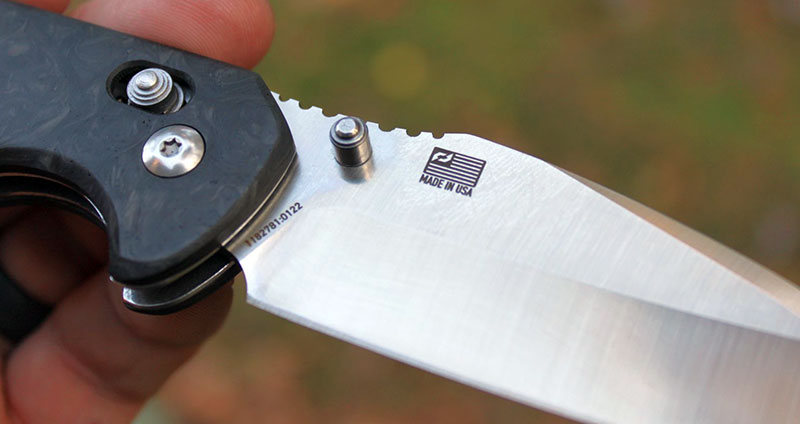
That edge grind transitions into a diagonal plunge line that intersects with the short sharpening choil at the base of the blade. Looks aren’t everything, but to my eyes the Radok’s blade shape is unpleasant – all long and beaky and poorly proportioned compared to the handle. Wharncliffe blades are certainly useful, especially for breaking down packaging and acting as a stand-in for a utility knife, but it’s kind of an eyesore that doesn’t get any better when it’s closed, since so much of the blade sticks out of the handles even when it’s put away.
Blade steel is CPM-S35VN, which is fine but not great at this price point – the Hogue-built Ritter RSK Mk1 G2 uses CPM-20CV and costs less, for instance. I’m not going to complain about the functionality of S35VN, of course – it’s a great steel, made with powdered metallurgy for a finer grain structure and a cleaner edge. S35VN is an update of the older S30V, with slightly less carbon and vanadium in the blend but with the addition of Niobium, giving S35VN the same excellent edge retention and corrosion resistance as its older brother, but with improved toughness (resistance to chipping) and being easier for the manufacturer to machine. The blade has a vertical grinder satin finish across all its surfaces.
Deployment & Lockup
The Radok uses what Schrade calls a “pivot lock” – ever since the functional patent expired on the Benchmade AXIS Lock in 2016, other manufacturers have been getting into the game but coming up with their own names since Benchmade still owns the right to the “AXIS Lock” name. Hogue has the ABLE lock, SOG has the XR lock, Gerber also uses the term pivot lock, and WE uses the term Slide Lock. They all function basically the same – a sprung bar slides into place on top of the tang of the blade to lock it open. Schrade’s implementation of the Pivot Lock is standard as far as this style of lock goes and is also used on the Truix folder which we’ll be reviewing in the future.
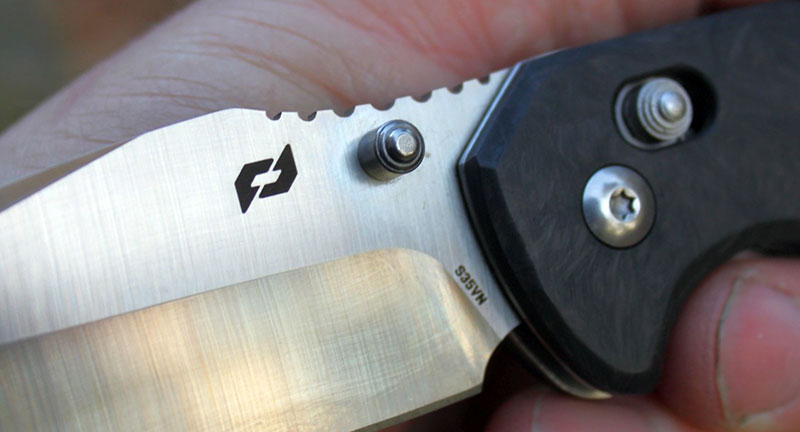
Deployment is via a pair of ambidextrous thumb studs with caged ball bearings in the pivot, and it gives a smooth flicking action with a light detent. Too light of a detent, in fact, with the considerable heft of the blade combined with the low resistance meaning you’re able to open the knife with just a strong wrist flick – an issue I haven’t run into in a modern high-end knife in a long time. Then again, the last time I carried a knife with a blade this big, it was the Zero Tolerance 0561, about ten years ago. And that knife didn’t flick open under its own weight without releasing the lock or applying pressure to the flipper or thumb studs. The Radok uses an external stop pin to locate the blade in the open position, anchored to the two liners for stability.
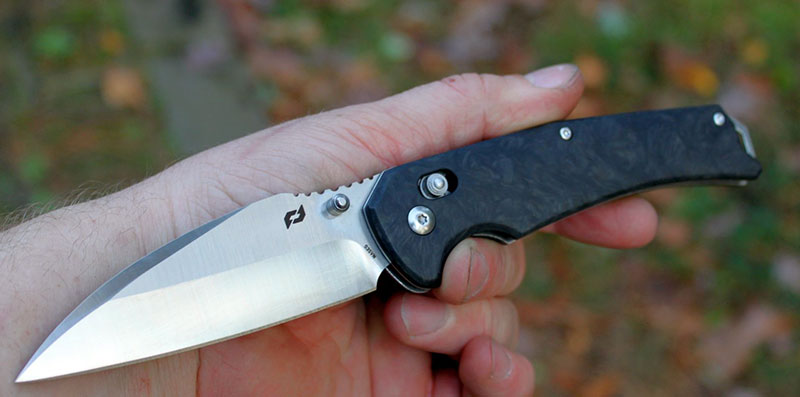
Lockup is fine, exhibiting no horizontal blade play but slight vertical blade play right out of the box. While horizontal blade play can usually be tuned out with pivot tension (less so on bearing knives such as this), vertical blade play is usually an issue of tolerances and design. It does close exceptionally smoothly, thanks to the low-friction bearing pivot and heavy blade as well as the lack of friction from the lock when it’s open, easily dropping shut under its own weight when the lock is released.
Features, Fit & Finish
The Radok doesn’t skimp on features for it’s $250 MSRP, with a high-end steel, carbon fiber handles, a sculpted pocket clip, and that fidget friendly lock and pivot. This is a knife that wows at first and disappoints on closer examination. It’s impressive to look at, especially the marbled carbon fiber handle scales – they’re deep and lustrous to look at, with an intricate contoured edge all the way around for a more comfortable grip. The blade grabs your attention, for better or for worse, and the overall appearance of the knife is radical and unique. It’s the small details that let this knife down. The ends of the scales are cut away from the liners to open up a lanyard pass through, and the corners of that pass through are pointy and sharp. They dig into the palm of your hand every time you open this knife.
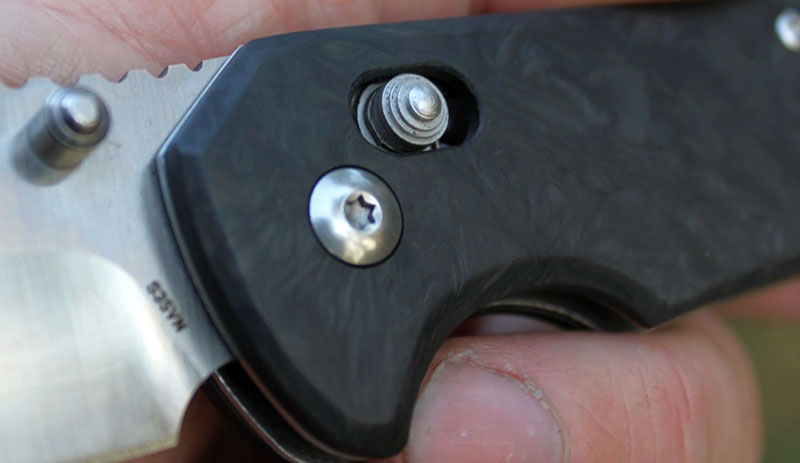
There’s also the world’s most aggressive jimping on the thumb ramp that takes off small pieces of your skin every time your thumb drags across it. Those beautiful, marbled carbon scales only line up with the stainless liners over about 50% of the circumference of the handles, and the edges of those liners have a visible burr on them that probably could’ve been taken off with a few seconds on a high grit belt sander – but weren’t. On the plus side, the blade is nicely centered when closed, and was sharp out of the box (even if the edge grind tapers as it nears the tip).
Speaking of things that weren’t done, when you have a knife with full stainless liners that stretches nearly 9” long when open, one would assume some lengths were gone to to reduce weight, but those steel liners aren’t skeletonized either. Maybe the assumption was that it doesn’t matter since the scales are carbon fiber? It’s baffling. While we’re on the topic of scales, it’s worth mentioning that the right side scale (the one with the clip on it) has several voids or pits in it while the other side doesn’t.
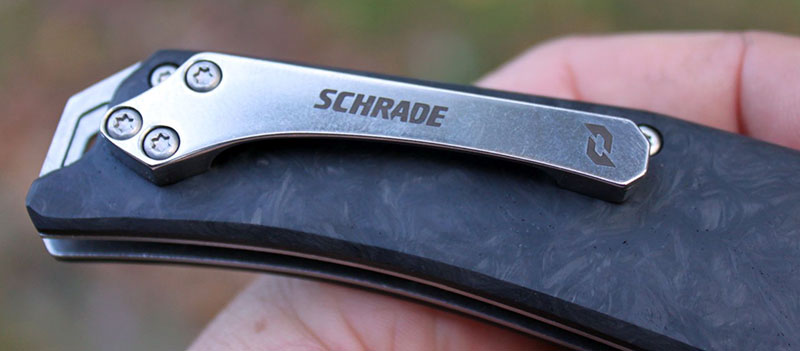
Pivot Lock knives are inherently ambidextrous, except the Radok isn’t – it has a sculpted pocket clip that’s only configured for right hand tip up carry, and it’s asymmetrical so it couldn’t work on the other side even if the scales and liners were tapped for ambidextrous carry. I’m not a native southpaw but even I can confirm the Radok works just fine opening and closing in the left hand, so this seems a strange oversight. I’ve railed against the proliferation of sculpted clips on “high end” knives before and I echo my statements here – they’re fancy to look at and functionally worse in every way. Even stranger, the sculpted clip on this knife is stainless steel rather than titanium so it has even less give, which is especially important on sculpted clips since they don’t have the natural spring effect of a stamped steel clip.
Construction of the Radok is bolt-through, with T8 screws for the pivot, and T6 screws for the body and clip screws. The pivot has a T8 head on both sides which is always a bad sign, confirmed by trying to turn it – the whole pivot spins, requiring a second T8 bit and preferably a third arm to hold it in place for adjustments. This means that the pivot barrel isn’t keyed the frame, another strange omission at this price point. Note that the clip must also be removed before disassembly since it’s in the way of the center body screw coming out. Those center body screws stand proud of the scales, while the rear ones are flush.

There’s quite a lot of branding on the Radok, with one side of the blade displaying the Schrade logo and the steel type, the opposite side with a serial number and a “made in USA” flag with the Schrade logo inside of it, and the pocket clip displaying both the brand and the logo. Schrade did confirm that an OEM in the US is making these Alpha-series knives for them, and I’m not sure which one, but I think they should lean on them a little harder or perhaps look elsewhere for a higher quality OEM because this knife is not impressive for a $250 MSRP.
Field Test
The Radok is big (8.75” long when open and 4.2 ounces), and it carries big. BladeHQ lists the handle thickness at 1.125” (meaning from top to bottom) but that’s inaccurate or irrelevant because while the handle measures it’s widest at the leading edge of the finger guard at 1.33” by my calipers, with the blade closed the widest point is 1.630” from back of handle to spine of blade. This thing wastes more pocket real estate than a TI-82 graphing calculator, especially since it’s also 5” long and 0.53” thick. The sculpted stainless steel pocket clip is truly miserable, being way too stiff to easily slide in and out of the pocket and with a very large contact spot and no ramp to ease entry. it also sticks out about a quarter of an inch for good measure and loves to catch on any nearby solid objects you walk past- sometimes pulling the entire knife out of your pocket, which is also unnerving since the blade is heavy enough for it to open itself. The huge pocket clip is brightly polished, leaving itself and the back corner of the knife with its pointy lanyard pass-through (also shiny and polished) sticking out to attract the wrong kind of attention when you might not want it.
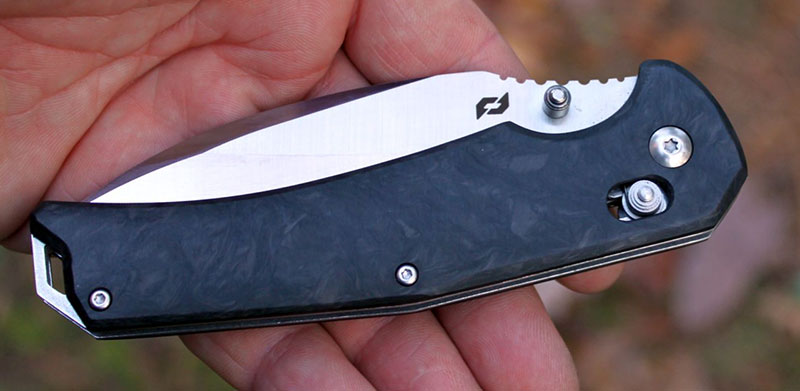
So it doesn’t carry well, but how does it feel in the hand? Well, it’s an ergonomic disaster, with the lanyard pass-through creating an instant hot spot that teams up with the bulky pocket clip to make using the knife generally unpleasant, as does the goofy thumb ramp jimping that you can use as a firestarter in a pinch. It’s also notably imbalanced, with way more weight in the handle than the blade. On the plus side, the action is good (when you’re opening it on purpose) and the Wharncliffe blade shape gives you a nice needle point tip. Points to the handle shape for a well-defined finger guard, although the lack of a forward finger choil with this much overall length to work with seems odd – it would certainly be useful.
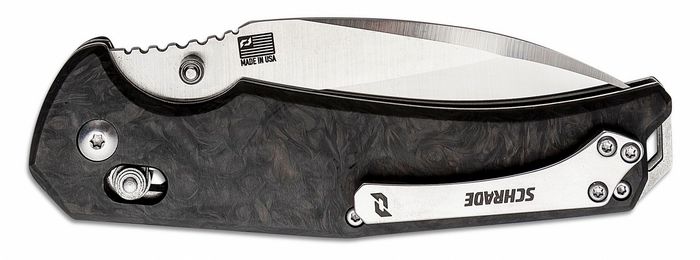
Wharncliffes make a natural substitution for a utility razor blade with the tip being considerably below the pivot, making it an effective box opener with minimal wrist angle needed for slicing open tape and packaging. For a Wharncliffe, the sharpened edge has more belly or curvature than you typically see, making it somewhat useful for roll cuts or food prep, although the wide angle of the primary bevel due to the shallow grind means it’s not especially well suited to that either. I’d like to see the blade of the Radok reconfigured with less meat on the spine and a higher tip into a drop point with a high flat grind, which would also allow it to take up less space in the pocket and cut better.
Alternatives
All these knives available at BladeHQ.
At $250 MSRP and $210 retail, the Radok is competing against other relatively pricey mid-range knives from manufacturers with a lot more experience in this field.As previously mentioned, the Hogue-built Ritter RSK Mk1 G2 seems like a much better deal. It’s also US-built with a premium steel – well, the RSK uses the superior CPM-20CV powdered metallurgy steel that’s a step up from S35VN. It’s 3.44” long blade is a high ground drop point with a tough stonewashed finish, and it also uses thumb studs and a sliding bar lock for deployment and lockup. While the Ritter RSK doesn’t utilize ball bearings in the pivot it’s hard to tell the difference with how smoothly it opens, and the ergonomics of the knife in the hand are far superior – better clip, no hot spots, better balance, and better quality. We reviewed the RSK Mk1 G2 a few years ago and it’s still the go-to recommendation for a larger high-end production folder, offering killer value for money and high quality for it’s $170 retail price. It doesn’t offer carbon fiber handles and comes in at a slightly heavier 4.5 ounces, but it’s worth the extra weight. It also offers ambidextrous tip-up carry with its deep carry bent steel clip so it’s lefty-friendly to boot.

There are Benchmade’s in this price range if you want the original AXIS lock, like the full-sized Freek folder. It’s pricier at ~$250 retail currently, but it offers a rare steel – powdered-metallurgy CPM-M4 high speed tool steel with a corrosion-resistant cerakote finish. M4 is an incredibly tough steel, and the Freek is basically a Griptilian on steroids – with a textured, layered G10 handle, a beefy AXIS lock with ambidextrous thumb studs, and a left or right-handed tip up deep carry clip. While others have figured out sliding bar locks now, Benchmade has been making them the longest, and the Freek is a great balance of heavy duty build with reasonable weight – it’s only 4.3 ounces for an 8.5” overall length, and it’s blade shape and geometry promise to be more useful than the Radok. Tool steels have more of a focus on toughness than edge retention but CPM-M4 has been popular in the EDC market despite this.

One knife that used to get brought up in basically every conversation about big EDC knives but has seemingly fallen by the wayside is the evergreen Spyderco Paramilitary 2 – or PM2 to it’s close friends. The price has gradually crept up over the years – this plain-Jane variant with black G10 and CPM-S30V steel now rings up at $185 – but there is a never-ending stream of special editions with upgraded steel and different colors for a little more money, like this brown Micarta handled version with Cru-Wear for ~$200 or this Digicam handled black-coated variant in S45VN for $199. The basics of the PM2 are still there after all these years, with solid ergonomics featuring a full forward finger choil, the excellent compression lock (albeit not lefty-friendly, although Spyderco now makes dedicated left-handed PM2 variants!), a four-position bent steel pocket clip, and a full flat ground clip point blade with a thumb hole opener. A modern classic, similarly sized to the Radok (3.44” blade, 8.3” open, 3.75 ounces) that’s still worth considering.

Finally, for about the same price ($215 currently) you can pick up a SOG Seal XR folder. It’s also large and in charge like the Radok, with a 3.82” long clip point also made from CPM-S35VN and a 9.125” overall length. It’s a heavy knife at 8.2 ounces thanks to full steel liner construction and it’s wide 0.18” blade thickness and 0.69” wide handles, but the Seal XR does the heavy-duty folder brief quite well. With its own version of the sliding bar lock called the XR Lock, the Seal XR features a ball bearing pivot and both a flipper tab as well as an oblong thumb hole for opening, heavily textured FRN handles with finger scallops, and an ambidextrous tip-up pocket clip with a lanyard pass-through.

Wrap-up
I hope this review doesn’t come off too harshly towards Schrade, because I’m always grateful for more competition in the market and no one wants to see a storied name fade into making awful garbage like Taylor Brands put out under the moniker. But the Radok is half-baked, overpriced, uncomfortable to use, and unpleasant to carry. It’s not particularly useful or attractive, it has quality and design issues, and it just seems a poor choice for the knife to serve as the flagship of Schrade’s entire brand revival. Unlike Gerber’s product renaissance, which has generally produced some very good knives like the Fastball, Sedulo and Savvy we’ve reviewed previously – with overall good design and the occasional minor issue – the Radok seems like a dud from the second it slips out of its packaging and painfully into your hand. I have higher hopes for the less strange-looking and smaller Truix folder, but as for the Radok folder, I recommend you spend your $200+ elsewhere for a larger folding knife.





